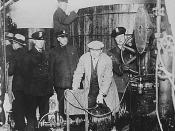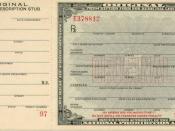The temperance movement founded in Cleveland, Ohio, in 1874 was organized to encourage modernized consumption of liquor or its complete prohibition. The movement consisted mostly of women with their children who couldn't or didn't want to deal anymore with drinking habits of their spouses and fathers. In America the temperance movement crested in the year of 1920 when the officials decided to put an end to drinking by passing the Eighteenth Amendment which prohibited any consumption and production of alcohol. The Prohibition of 1920-1933 was started to improve health of the population of the country, reduce the tax burden created by prisons, and solve some social problems. The idea behind this "noble experiment," was indeed noble, but not one goal of this plan ever came to reality. The government could not control the will of the people; everyone still drank, no matter who they were or how much they had to pay for it.
The gangs became more powerful as they got a new source of income; police became powerless in this mayhem, Detroit became the bootlegger's dream town since it was close to Canada and liquor could easily transported to this city. Also government lost one of its major sources of income, as the alcohol became prohibited they could not tax it, and therefore did not have enough money for the enforcement of this law. The Prohibition of 1920-1933 failed because government simply could not enforce it.
The main goal of Prohibition was to reduce the amount of alcohol consumed by the people living in the country. The improved health of population, solved social problems, and reduced tax burden would follow if the main goal was achieved. The Prohibition could not succeed in any way if the consumption of alcohol was not reduced. The Eighteenth Amendment had failed to...


